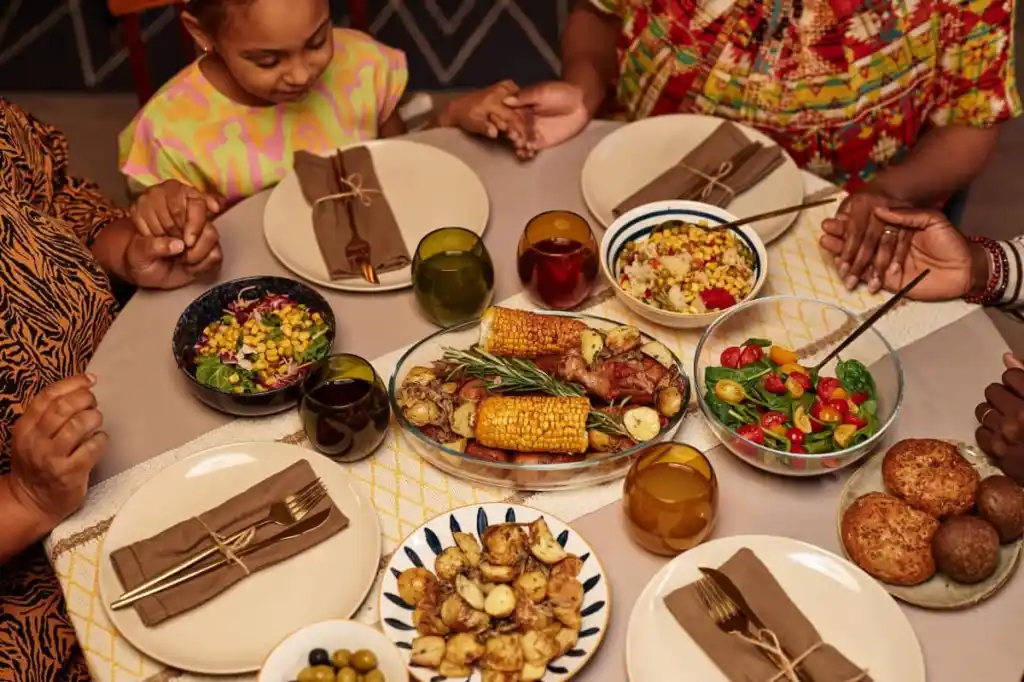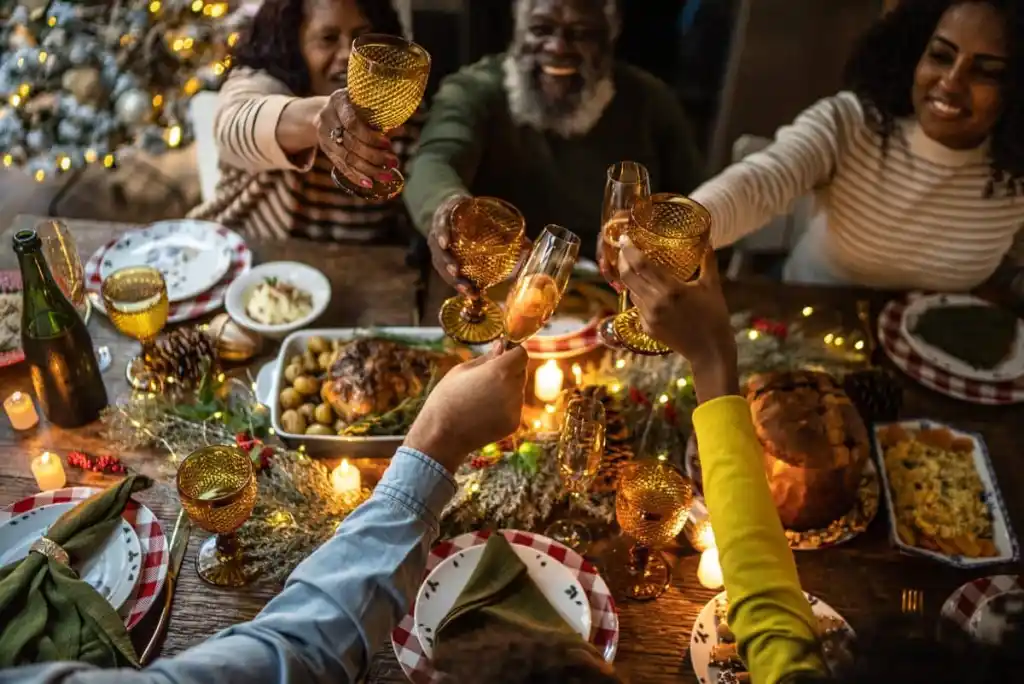Kwanzaa is a time of joy, cultural reflection, and coming together with loved ones — and for many of us, that includes our furry family members. But while the celebrations are filled with warmth and excitement, they can also bring some hidden risks for dogs. With their curious nature, pups are often drawn to the hustle and bustle of holiday preparations, which can sometimes lead to trouble. However, ensuring your dog’s safety doesn’t mean dialing back the festive fun. A little extra awareness and preparation can go a long way. Below, we’ll explore some common Kwanzaa hazards for dogs and how to keep your pooch out of harm’s way.
Table of contents
What is Kwanzaa?
Kwanzaa is a week-long celebration observed annually from December 26 to January 1. It was created in 1966 by Dr. Maulana Karenga — a professor of Africana Studies — as a way to honor African heritage and culture. The name Kwanzaa comes from the Swahili phrase “matunda ya kwanza,” which means “first fruits.” The holiday was established during a time of cultural and social change. It aimed to bring African Americans together and promote unity and pride in their cultural roots.
Kwanzaa is built around seven core principles, known as the Nguzo Saba. These principles are Umoja — unity, Kujichagulia — self-determination, Ujima — collective work and responsibility, Ujamaa — cooperative economics, Nia — purpose, Kuumba — creativity, and Imani — faith. Each day of the holiday is dedicated to one of these principles, bringing families together in reflection and unity. Symbols of Kwanzaa, such as the kinara — a candle holder, the mkeka — a woven mat, and the kikombe cha umoja — or unity cup, play a significant role in the festivities.
How is Kwanzaa celebrated?
While Kwanzaa celebrations can vary from household to household, they typically center on gathering with family and friends to reflect on the principles of the holiday. Homes are often decorated with African-inspired art and colors, with the kinara taking a place of honor. Each evening, a candle is lit to symbolize the day’s principle, and discussions and activities are centered around that theme.
Families come together to prepare and share traditional meals, often featuring dishes that pay homage to African, Caribbean, and African American cuisine. Gift-giving is another meaningful part of the celebration, with an emphasis on handmade or educational items that embody Kwanzaa’s values. Although Kwanzaa is primarily observed in the United States, the holiday has gained recognition around the world, especially among those who appreciate its focus on community, culture, and heritage.
Common hazards for dogs during Kwanzaa
As you immerse yourself in the warmth and traditions of Kwanzaa, don’t forget to prioritize your furry friend’s safety. These are the top Kwanzaa hazards for dogs to watch out for:
Candles and open flames

The kinara, with its seven candles, is a central symbol of Kwanzaa, representing the principles of the holiday. However, open flames can be dangerous if your dog is curious or has a wagging tail that might knock things over. To prevent accidents, always supervise lit candles and place them on sturdy surfaces out of your pet’s reach. You could even consider using flameless LED candles as a safer alternative while still honoring the tradition.
Decorations

During Kwanzaa, homes come alive with vibrant decorations like ribbons, streamers, and small ornaments. These items can be attractive to dogs who love to chew or play with new textures. Unfortunately, swallowing them could lead to choking hazards or intestinal blockages. Therefore, be strategic about where you place decorations. Even better, choose pet-friendly options, such as larger, non-toxic items that are less likely to be ingested.
Moreover, with additional lighting and electronic decorations, there are often more electrical cords around the house during the holidays. Dogs — especially puppies — may find cords tempting to chew on, which can lead to electrical shocks or burns. As such, you’ll want to use cord protectors and keep cords tucked away to prevent your dog from accessing them. If you have a particularly curious dog, consider decorating a room that’s off-limits to them.
Holiday plants

Certain plants commonly seen during the holiday season can be harmful to dogs if ingested. While not specific to Kwanzaa, plants like poinsettias, holly, and mistletoe often make their way into festive decor. If you plan to include greenery in your celebrations, be sure to place them well out of your dog’s reach. A quick online search or a call to your vet can help you identify pet-safe options. For a risk-free alternative, consider using artificial plants to keep the festive vibe without the danger. If you suspect your dog has ingested a toxic plant, contact your veterinarian right away.
Festive foods and drinks

Food is one of the biggest concerns for pets during any holiday, and Kwanzaa is no exception. The celebrations often feature a feast of traditional dishes, and while it may be tempting to share with your dog, it’s important to be cautious. Many common ingredients in these dishes — such as onions, garlic, certain spices and nuts, raisins, grapes, and chocolate — are toxic to dogs. Additionally, rich and fatty foods can upset your pet’s stomach and potentially lead to serious conditions like pancreatitis. Not to mention, foods containing xylitol — a common sugar substitute — are especially dangerous. Even small amounts of xylitol can cause a rapid drop in blood sugar, resulting in life-threatening symptoms.
Thus, ensure your pup doesn’t have access to the feast, and remind your guests not to feed them table scraps. Stick to your dog’s regular diet and provide them with safe treats designed for dogs. If you’d like to include them in the festivities, offer plain, cooked vegetables. Alternatively, serve them unseasoned, cooked turkey in small portions, without skin or bones.
Aside from food, drinks are another aspect to be mindful of during Kwanzaa celebrations. Alcoholic beverages, in particular, are highly toxic to dogs. Even non-alcoholic drinks, such as holiday punches or eggnog, may contain ingredients like caffeine, chocolate, or high levels of sugar that can harm your pooch. As a precaution, store drinks safely and clean up spills right away to avoid accidental ingestion.
Gifts and wrapping materials

Gift-giving is a cherished part of Kwanzaa, and unwrapping presents is always exciting. However, the aftermath often leaves small items like wrapping paper, bows, ribbons, toy parts, and even plastic scattered on the floor. These objects can be particularly enticing to dogs, who may be drawn to the crinkly sound of paper or the shiny appearance of ribbons and bows. If ingested, they can pose serious risks, such as choking or intestinal blockages.
To prevent this, quickly dispose of wrapping materials in a securely lidded bin, and be sure to supervise your dog when opening gifts. Furthermore, if you’re gifting or receiving edible treats, avoid leaving them unattended. Dogs have an extraordinary sense of smell and may be able to detect snacks in wrapped boxes, which could be harmful to their health if consumed.
Open doors

With people coming and going, there’s a higher risk of your dog slipping out unnoticed. Make sure all guests are aware of your dog’s presence and ask them to be cautious when entering or leaving. You might want to consider using baby gates to block off certain areas or keeping your pup on a leash when the door is frequently opened. It’s also a good idea to double-check that your dog’s ID tags and microchip information are up to date, just in case.
Stress and noise

The holidays can be a bit overwhelming, not just for people but for pets, too. The sounds of music, laughter, clinking glasses, and lively conversations can trigger anxiety or fear in dogs. They may become restless, and in some cases, this stress can lead to behavioral changes or even attempts to escape the situation.
As such, pay attention to your pet’s body language. Provide comfort and reassurance when needed. It’s also important to create a safe, quiet space for your dog where they can retreat if the festivities become too much. This could be a cozy room stocked with their favorite bed, toys, and perhaps some soothing music to drown out the party sounds. If your dog is particularly anxious, consider using calming aids like a ThunderShirt or consult your veterinarian for additional recommendations.
By staying mindful of potential hazards and taking simple precautions, you can ensure both you and your dog enjoy a safe and joyful Kwanzaa. After all, a safe dog is a happy dog — and that’s one more reason to celebrate during this special time of year!









